#Hexacorallia
Text
Taxonomy Tournament: Cnidarian Finale
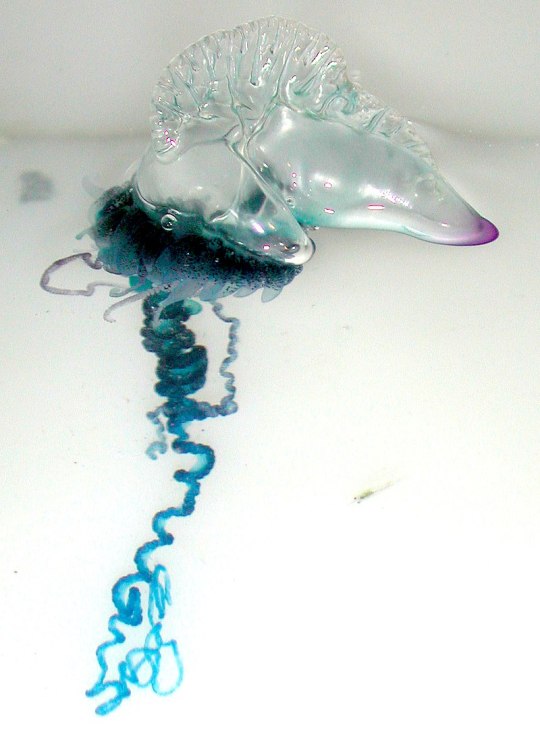
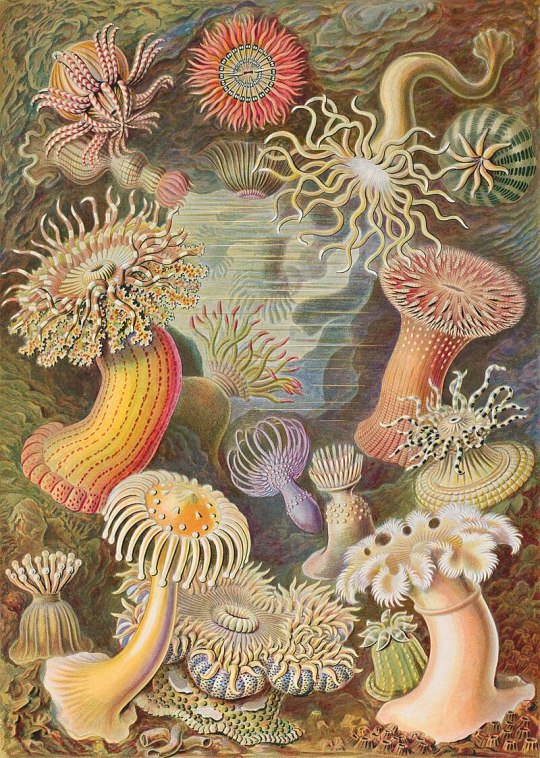
Hydrozoa. This class is of predatory cnidarians, some of which are colonial, incllude hydras and the Portuguese Man o' War
Hexacorallia. This class is made up of aquatic animals with 6-fold symmetry. It includes stony corals and sea anemones
#animals#biology#polls#poll tournament#zoology#jellyfish#hydras#portuguese man o'war#cnidarians#coral#sea anemones#Hydrozoa#Hexacorallia#0x9v0x36
331 notes
·
View notes
Text

A zoanthid coral (Zoantharia sp.) in the Great Barrier Reef, Australia
by Alexander Semenov
#zoanthid corals#corals#cnidarians#zoantharia#hexacorallia#cnidaria#wildlife: australia#wildlife: oceania
59 notes
·
View notes
Photo

Ringed plate coral (Pachyseris sp.) at Pulau Bangka in Indonesia
scubaluna
1K notes
·
View notes
Text

Haddon's sea anemone (Stichodactyla haddoni)
Photo by Loh Kok Sheng
#haddon's sea anemone#sea anemone#stichodactyla haddoni#stichodactyla#stichodactylidae#actinioidea#enthemonae#actiniaria#hexacorallia#anthozoa#cnidaria
27 notes
·
View notes
Video
youtube
Here it is! Another expedition completed.
This time, I came across an English sole (Parophrys vetulus)! Who jumpscared me! There were also many shiner perch (Cymatogaste aggregata), plumose anemone (Metridium farcimen), a dungeness crab (Metacarcinus magister), three red rock crabs (Cancer productis), and miscellaneous gunnel fish and an unknown sea star.
#rov-e4-4-23#unglish sole#flatfish#crab#red rock crab#dungeness crab#shiner perch#plumose anemone#gunnel fish#metacarcinus magister#cancer productis#eukarya#animalia#chordates#cnidaria#arthropoda#actinopterygii#pleuronectiformes#pleuronectidae#hexacorallia#actiniaria#metridiidae#metridium farcimen#m. farcimen#p. vetulus#parophrys vetulus#embiotocidae#cymatogaster aggregata#crustacea#malacostraca
2 notes
·
View notes
Text
Kenzie Taylor blowjob big fat cock
Amateur Doggystyle w/ Creampie
Throated skank spits cum
Lesbea German teen redhead valentine 69 and scissors with older woman
Latina teen getting naked and playing with her fat pussy
British GF Blows Me While Watching Love Island
Indian teen boy Oil massage
Best Cumshot Compilation
Big dick of India
Horny Lance loves to bang swap wifes
#narkomania#argled#overbrag#taction#semi-diurnal#unshakably#subocularly#forcingly#aguelike#antitropical#promagisterial#cutset#bluster#renovating#alabastrums#priestianity#Canoeiro#Hexacorallia#unharrowed#axonometry
0 notes
Note
*breaks into ur askbox through a plaster wall*
hi
i am genuinely fascinated by how you do patterns/ornaments in your art. I don't have like, the slightest bit of patience to do those, but I'm still hella interested to know how ppl do them. Do you plan them out or is it 'fuck it we ball' type of process? Do you usually go into more symbolic meanings (like with the floral ornaments) or add whatever fits aesthetically? Also are there any particular artists that inspire you when drawing them?
("good luck getting to me i'm behind 7 firewalls" meme voice) good lucky getting to [my blog] i'm behind 7 [layers of bricks]
hiii ok let's get serious now
while it'd be easier to tell me about my #process on a case by case basis (so if you have an image/images in particular you'd like to know how i did the patterns of i could likely be more precise in my response) the Vast Majority of the time truly i am ballin. at most I might sketch out where i want Big Pieces, and where i'll fill out with smaller things However Comma there are motifs that keep coming back. and i'm sorry to tell you this. one of them is The Patience To Do So. in no order whatsoever:
floral motifs. i never go for something that Actively Looks Like A Real Flower on purpose: the language of flowers is very dependant of era and place, and a flower that means [x] in 1910s Russia might not mean the same in 1870s England.
vegetal motifs in general, so leaves, vagyuely ivy-looking stuff, stuff inspired by mushrooms & fungi, etc
animal motifs, typically associated with the characters i'm drawing. i might draw stylized birds, wings, horns, serpents/snakes, scales, etc.
eyes, mouths, wounds, or anything that looks kinda ()-like. it can also. look quite yonic depending on the context so. yeah you could say i draw those motifs.
anatomical motifs, inspired by scientific diagrams of the epidermis, of cells, of different organs and body parts, etc. i rely a lot on [this] (Henry Gray’s Anatomy of the Human Body) because you have a lot of engravings for every body part you could think of.
random motifs: spikes, spirals, dots, waves, curls, blobs, "ladders",...
i do equal parts symbol & vibes. as mentioned above i'll often fit in animals that i associate with the characters i have drawn, add more anatomical stuff depending on the characters,... but a lot of the "filler" squiggles are pure vibes. i use them to connect symbols together. also most of the characters i draw with these types of patterns are in equal parts anatomy of the body and anatomy of the vegetal so truly i'm tailoring it here.
as for artists i'm inspired by those are the two i always mention:
Ernst Haeckel especially his Kunstformen der Natur (<- link to the Gallica digitalization, but if you google search that you'll also see plenty of good images). He was mostly a biologist & his KdN is drawings he did within his research, a bunch and i mean a buuunnnnccchhh of very beautiful drawings of so many lifeforms on earth. i often reuse his drawings of hexacorallia in peterstakh artworks. those types of artworks if you see what i'm seeing.
i'm also incredibly inspired by Solange Knopf's artworks, and routinely joke that i keep being inspired by her art. i loooove how she does it very freeflowing, packed with so much details
again, i'd probably have more to say if you pointed to an image in particular, but for the most part this is it chrewly!
you must learn patience... you must learn to enjoy doing the squiggles... this is the only way... THANK YOU FOR QUASTION
25 notes
·
View notes
Text
Some more NEXUS ALPHA art, this time featuring Reefdancer, Hexacorallia's Frame. She's a little shorter than Nexus, but makes up for it in speed and raw punching power. She's also better at moving through water than some other Alpha frames, so whenever a threat is subaquatic or coastal, Hex is often the first on the scene.
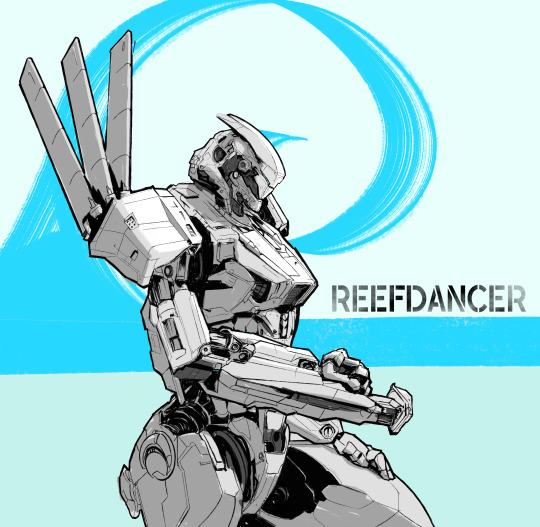

#nexus alpha#mech#mecha#giant robot#my oc's#my art#character design#d'you like robots? i got ROBOTS#inspired by:#Armored Core 6#Pacific Rim#Gundam
51 notes
·
View notes
Note
Least Useful Animals to form a Contract With for Ninja Purposes
Aggregation of Manatees
Creep of Tortoises
Flock of Sheep
Hexacorallia of Sea Anemones
Ostentation of Peacocks
Snuggle of Sloths
8 notes
·
View notes
Text
Side Order of Coral
Some random information on corals that may or may not relate to the Splatoon 3 DLC (Side Order)! We don’t have any real idea what the story is going to be about, but I guess it can be food for thought. Included pictures from the trailer and corals, so it got a little long...
Under the cut it goes!
First, all corals are made up of polyps; the majority of these tiny organisms make an exoskeleton at their base made of calcium carbonate. They’re actually related to jellyfish and anemones! Most corals are a colonial organism, meaning they are made up of hundreds to hundreds of thousands of polyps living in a group. There are two main sub-classes of coral, depending on how many tentacles each polyp has; six (Hexacorallia) or eight (Octocorallia). Hexacorallia includes the hard corals, while Octocorallia includes the soft. Most corals can photosynthesize, but they also eat plankton or small animals that get stung by the nematocysts on the polyps’ tentacles, in the same manner as jellyfish. Feeding usually happens at night when the polyps stick out of their pockets in the body of the coral.
When you think “coral”, you probably think of colorful coral reefs. Most of these types get their colors from a type of symbiotic organism called “zooxanthellae”! They live with the coral, inside the tissues of the polyps, where they’re protected and thereby able to photosynthesize. The largest part of the nutrients produced by the zooxanthellae’s photosynthesis (almost 90%) is taken in by the coral, and allows the polyps to grow and reproduce, expanding the coral reef. However, most of the corals we saw in the trailer are bleached; this can happen for a variety of reasons, such as pollution, rising water temperatures, or other stress on the coral, which causes the polyps to expel the zooxanthellae and lose their color. If they go long enough without their zooxanthellae, the coral eventually dies.

[Image of the main Octoling standing in a strange, white Inkopolis Square. The coral in the background is bleached and crumbling.]
When a coral dies, it leaves behind its skeleton. This skeleton is covered in tiny holes, showing where the polyps used to be.
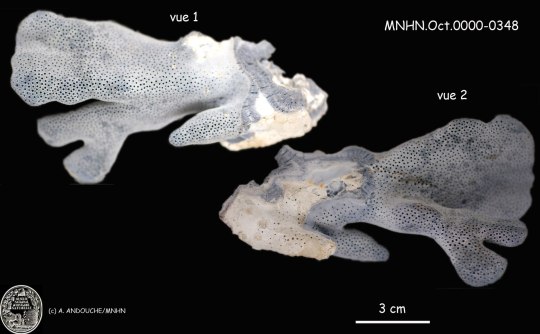
[Image of a blue coral skeleton, covered in little holes the polyps used to live in. Blue coral is the only octocoral known to form a stony body.]
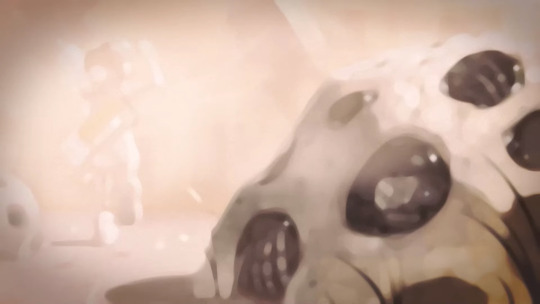
[Image from the SO trailer; foreground object looks like a skull, but with far too many holes. Possible coral skeleton.]
Slight side note, but as anemones also get their colors from their zooxanthellae, I thought it was interesting that Annie (in Inkopolis Plaza) also appears to be losing her color. Her hair is much paler than it was in the first game, suggesting the effects we see in Side Order may be making their way around...

[Image comparing Annie in Cooler Heads from the first game (left) to the thrid game’s DLC (right).]
Onto coral types! Stony corals, as the name would suggest, build themselves a hard skeleton. These are the types that form the coral reefs, and come in a huge variety of shapes and sizes. They tend to prefer nutrient-poor water with access to lots of sunlight, relying on their zooxanthellae for a large portion of their nutrients. The majority of stony coral polyps are Hexacorallia, meaning their polyps have six tentacles each. We saw at least one hard coral in the trailer; the brain coral! As the name suggests, they have a winding growth pattern that makes their surface look like a brain. We’ll get back to this in a moment!

[Image of a type of bleached brain coral]

[Image of the brain-like object (probably coral) from the SO trailer]
Soft corals, for the most part, do not form a rigid skeletal structure. They tend to form a tougher core with a fleshy exterior for protection, and as a result are more flexible than stony corals. The are also colonial, but don’t form reefs; however, they are still part of the reef ecosystem. Some types can also survive and thrive in the deep sea, getting their nutrients by filter feeding as they sway in the current instead of zooxanthellae. All soft coral polyps are Octocorallia, as they have eight tentacles.
This, of course, could have a potential connection to another eight-tentacled someone who happened to spend some time in the Deepsea...
Returning to our brain coral thought; corals also have their own nervous system! Their nervous system is of the most simple type, lacking a brain, and is referred to as a “nerve net”. This net connects all the polyps, allowing them to transmit impulses in any direction; it is also what allows anemones and jellyfish to swim, though slowly and largely at the mercy of the current. Further, the nerve net of cnidarians (corals, jellyfish, anemones, etc.) is thought to be the evolutionary precursor to bilaterian nervous systems; those involving a central nervous system with a brain. There are a few instances of nerve-like images, which also bear resemblance to some types of sea fan (a soft coral), and could tie into a potential “experiment”-based story line (similar to Octo Expansion).

[Image from Side Order trailer; pink lines creep down the white walls and over the black ground in a similar manner to veins or nerves.]
Finally, polyps reproduce either sexually (via spawning) or asexually, budding off clones of themselves to grow their main body/skeleton. Cloning can also happen with fragmentation, when a chunk of the coral is broken off by a storm/etc., and the colony begins to from a separate colony. As we saw clones in the trailer, this ties in nicely to our ongoing coral theme.

[Image of what appears to be clones of the main Octoling; the ones farther back are bleached.]
We don’t yet know what this DLC is going to be about, but coral, and coral imagery, features heavily in the trailer. All of it is dead.
Sources: [1], [2], [3], [4]
#splatoon#splatoon 3#side order (splatoon)#octoling#agent eight#agent 8#it's coral time babeyyyy#there were a few times I wanted to speculate about what it could mean#but i felt like sticking with just information might be best#if you have any spec thoughts please drop them on me tho!!#or don't and make a separate post i lurk in the tag sometimes#annie (splatoon)
19 notes
·
View notes
Text
Taxonomy Tournament: Cnidarians


Octocorallia. This class is made up of aquatic colonial animals with 8-fold symmetry. It includes soft corals and sea pens.
Hexacorallia. This class is made up of aquatic animals with 6-fold symmetry. It includes stony corals and sea anemones
#animals#biology#polls#poll tournament#zoology#sea pens#coral#cnidarians#sea anemones#Octocorallia#Hexacorallia#0x35v0x4a
51 notes
·
View notes
Text

A bristleworm (Polychaeta sp.) amongst the orange cup coral (Tubastraea coccinea) in Bonaire, South America
by Pierrette Wagner
#bristleworms#polychaete#polycheata#annelida#orange cup coral#corals#cnidarians#tubastraea coccinea#tubastraea#dendrophylliidae#scleractinia#hexacorallia#cnidaria#wildlife: bonaire#wildlife: south america
138 notes
·
View notes
Photo

Kneecap coral (Cycloseris patelliformis) in Pulau Bangka, Indonesia
scubaluna
102 notes
·
View notes
Text
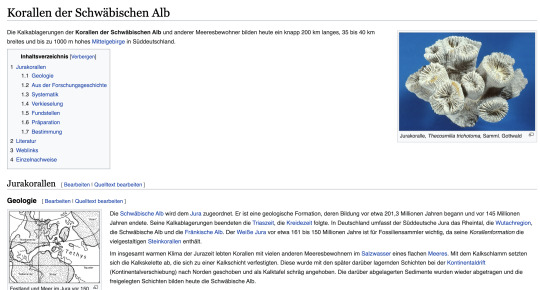
Zitatsammlung aus Wiki-Artikel: RICHTIG, RICHTIG GUT
Der Weiße Jura vor etwa 161 bis 150 Millionen Jahre ist für Fossiliensammler wichtig, da seine Korallenformation die vielgestaltigen Steinkorallen enthält.
Im insgesamt warmen Klima der Jurazeit lebten Korallen mit vielen anderen Meeresbewohnern im Salzwasser eines flachen Meeres. Mit dem Kalkschlamm setzten sich die Kalkskelette ab, die sich zu einer Kalkschicht verfestigten. Diese wurde mit den später darüber lagernden Schichten bei der Kontinentaldrift
(Kontinentalverschiebung) nach Norden geschoben und als Kalktafel schräg angehoben. Die darüber abgelagerten Sedimente wurden wieder abgetragen und die freigelegten Schichten bilden heute die Schwäbische Alb.
Die ersten Zeugnisse über die Korallen der Schwäbischen Alb stammen von Balthasar Ehrhart 1748, wo er in der ersten paläografisch-faziellen Karte Südwestdeutschland die Gegend nordwestlich von Ulm bis zum Nördlinger Ries als Regio corallifera, korallenführende Region, bezeichnet
Über den Bau der Polypen werden die Korallen den sechsstrahligen Blumentieren (Hexacorallia) zugerechnet und gehören dort zur Ordnung der Steinkorallen (Scleractinia). Die weiteren Unterordnungen mit Differenzierungen in Familien, Gattungen und Arten sind in der Forschung nicht endgültig geklärt. Wesentlich für diese sechsstrahligen Jurakorallen mit ihren möglichen vielfachen Septenzahlen ist die Fähigkeit, über die Kalkbildung zusammen mit anderen Lebewesen Riffe aufzubauen.
Auf Äckern sind die ausgewitterten, verkieselten Korallen meist ockergelb durch Eisenoxide gefärbt. Kalkbrocken mit grauen Strukturen, meist als Riffschutt, lassen Korallen erkennen, die mit Salzsäure (HCl) freigeätzt werden können. Dazu werden die Stücke in Plastikgefäßen mit Wasser bedeckt. Dann wird jeweils eine kleine Menge Salzsäure zugegossen. Das Kohlen(stoff)dioxid (CO2) entweicht sprudelnd, während das Wasser langsam durch das entstehende Calciumchlorid (CaCl2) zu einer Salzlösung wird. Diese dämpft bei weiterer Säurezugabe die anfänglich heftige Reaktion (CaCl2 ist toxisch unbedenklich). Schlecht verkieselte Stellen können mit Wachs oder Vaseline abgedeckt werden. Einzelne Kalkstellen entfernt man auch mit einem Infusionsbesteck tropfenweise.
Auf der Ostalb bietet das Riffmuseum[1] in Gerstetten Einblicke in die reiche Riff-Fauna mit sehr gut erhaltenen Einzelbeispielen, aber auch das Museum[2] in Nattheim. Das 1977 eröffnete Urweltmuseum[3] Aalen ist das größte städtische Museum für Geologie und Paläontologie in Baden-Württemberg. Es beherbergt ebenfalls eine besondere Sammlung von Jurakorallen mit ihrer Begleitfauna.


Schlusszitat von https://www-old.eglofs.de/korall2/koralle5.htm
Nach einigen Klimamodellen ist mit einer Kaltzeit erst in etwa 60 000 Jahren zu rechnen, verbunden mit einer Zwischen- abkühlung in etwa 25 000 Jahren. Die moderne Chaosforschung jedoch lehrt, dass kleine Ursachen in unserer Welt oft größte Wirkungen haben können. Das beweisen einzelne vulkanische Aktivitäten und auch "El Nino" mit ihren Auswirkungen auf unser Klima. Das Risiko der menschlichen Einwirkungen auf die Korallen und unser Klima ist damit auch kaum genau berechenbar. Auf unserer Erde bleibt uns nur die einzige
Möglichkeit eines behutsamen Umgangs mit ihr.
Eines dürfte ziemlich sicher sein: Unsere Sonne wird in weiter Zukunft durch ihre nuklearen Prozesse immer heißer werden und sich weiter zu einem Roten Riesen aufblähen. Sie wird in etwa vier bis fünf Milliarden Jahren die Erde in sich aufnehmen, bevor sie als "Weißer" oder "Schwarzer Zwerg" in sich zusammen- brechen und bei einer Weltraumtemperatur von -270 °C ihren Weg im All nehmen wird.
0 notes
Photo
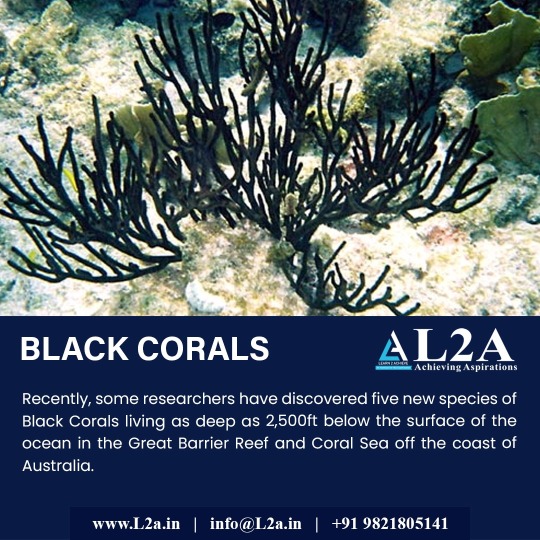
Current Affairs | 30-11-2022 | L2A
1) Antipatharians, also known as black corals or thorn corals, are an order of soft deep-water corals.
2) These corals can be recognized by their jet-black or dark brown chitin skeletons, surrounded by the polyps (part of coral that is alive).
3) Antipatharians are a cosmopolitan order, existing at nearly every location and depth, with the sole exception of brackish waters.
4) However, they are most frequently found on continental slopes under 50 m deep.
5) A black coral reproduces both sexually and asexually throughout its lifetime.
6) Many black corals provide housing, shelter, food, and protection for other animals.
7) Black corals were originally classified in the subclass Ceriantipatharia along with ceriantharians (tube-dwelling anemones), but were later reclassified under Hexacorallia.
Though they have historically been used by Pacific Islanders for medical treatment and in rituals, its only modern use is making jewelry.
9) Black corals have been declining in numbers and are expected to continue declining due to the effects of poaching, ocean acidification and climate change.
#currentaffairs#currentaffairs2022#currentaffairsquiz#l2a#learn2achieve#IAS#UPSC#upscpreparation#upscprelims#upscmotivation#upsccoaching#explore#explorepage#blackcoral#coral
0 notes
Photo

Colin Prahl “Hexacorallia” #astoundingarte #art #artwork #artist #modern #modernart #contemporary #contemporaryart #abstract #abstractart #graffiti #urbanart #streetart #streetartist #painting #graffitiart #brooklyn #brooklynart #colinprahl #cityscape #citybuilder #abstractcity #colors #waterfall #flow #shapes #illustration #dimensions #opticalillusions #illusions (at New York City, N.Y.) https://www.instagram.com/p/CfXRQepONff/?igshid=NGJjMDIxMWI=
#astoundingarte#art#artwork#artist#modern#modernart#contemporary#contemporaryart#abstract#abstractart#graffiti#urbanart#streetart#streetartist#painting#graffitiart#brooklyn#brooklynart#colinprahl#cityscape#citybuilder#abstractcity#colors#waterfall#flow#shapes#illustration#dimensions#opticalillusions#illusions
0 notes